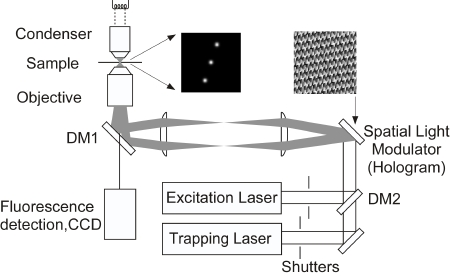Holographic optical tweezersTo trap multiple particles, we have recently implemented holographic optical tweezers with a liquid crystal spatial light modulator (SLM). This system will be used to trap multiple ion sensitive nanosensors and monitor the spatial and temporal dependence of ion concentrations in microfluidic devices and inside cells. Reference: "Applied Computing Techniques for Holographic Optical Tweezers," Daniel Gruss, University Honors College Senior Thesis, June 2010. |
|
 |
 |
|
These experiments are performed in an inverted microscope system that incorporates trapping and fluorescence excitation and detection. The phase hologram displayed on the SLM acts as a grating to diffract the incident light. The lens relay system reimages the SLM plane onto the back focal plane of the microscope objective, which then Fourier transforms the hologram into the desired intensity pattern in the sample plane. We have used this technique to trap an array of 1-μm polystyrene spheres with a 655 nm diode laser. |
|
 |
 |
|
To improve the holographic trapping we have used the holograms to compenstate for optical aberrations in the SLM and the rest of the optical path. The computer generated holograms are adjusted to include phase corrections corresponding to the standard Zernike spatial polynomials that characterize different optical aberrations. We optimize the correction by measuring the tweezer trap spot size on a CCD camera and calculating a spot sharpness parameter M that is a minimum when aberrations are reduced. The figure at right shows this parameter as the Zernike coefficient for the defocus aberration is adjusted. By choosing the coefficient that minimizes M, we improve the focused spot and maximize the trapping force. |
|